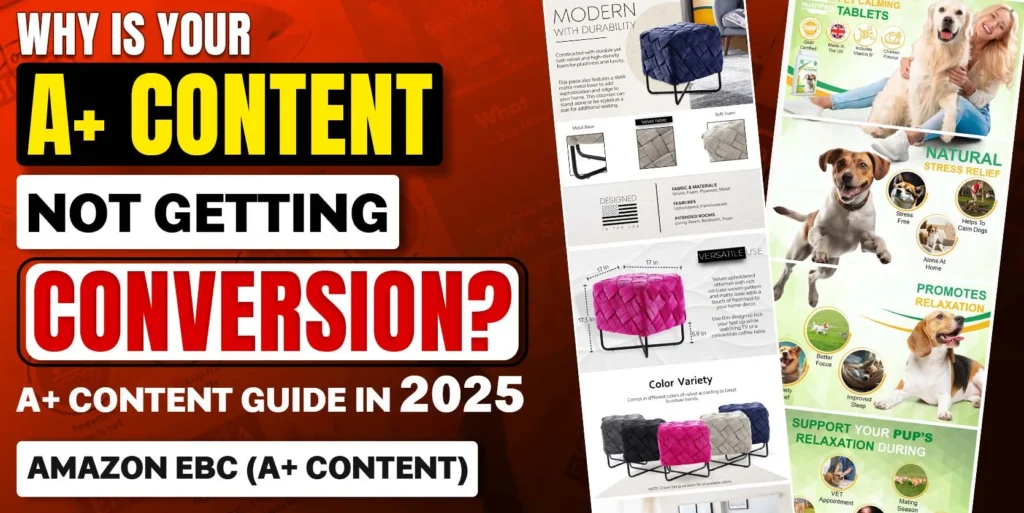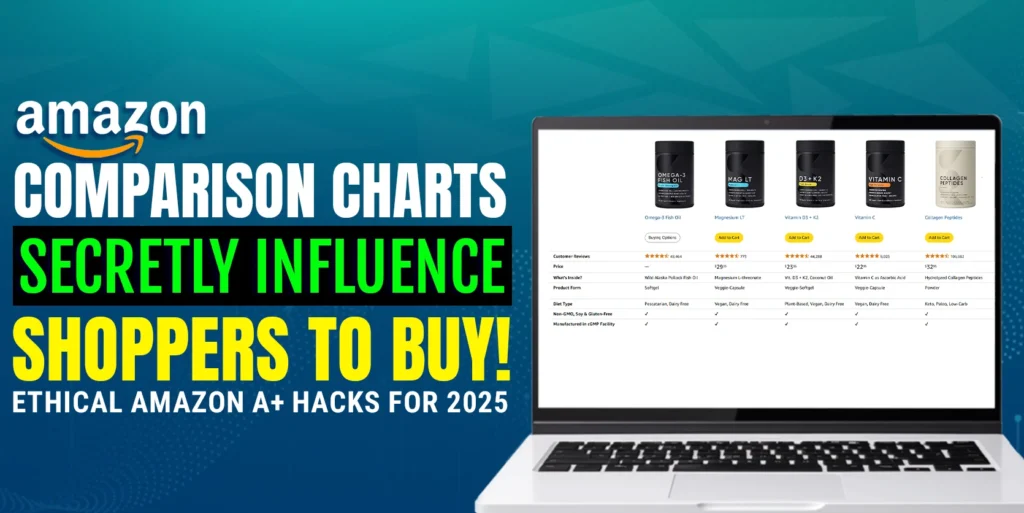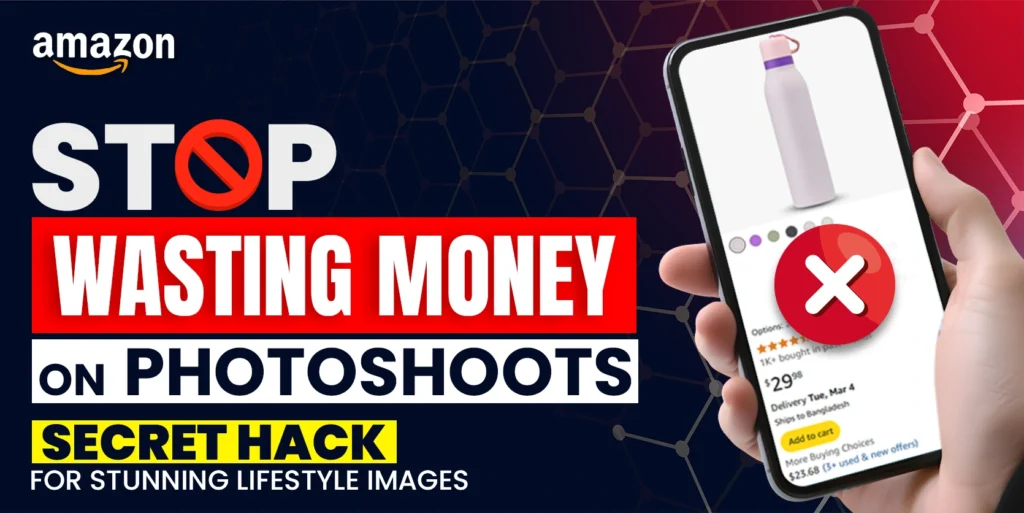A+ content plays a crucial role in converting visitors into customers on Amazon. A+ Content enables sellers to share fascinating brand stories within product descriptions that can capture the attention of potential buyers. In fact, Amazon claims that basic A+ content can boost sales by up to 8%. And if you go premium? You’re looking at a whopping 20% increase! Sounds amazing, right?
But here’s the twist-many sellers are not seeing an increase in sales despite having A+ Content on Amazon. What could be the reasons? Let’s find out.
In this guide, you will learn what content you should improve, and what modules are the best. We will find the answer to the question: Why is your A+ content not getting any conversions?
This is going to be an A+ content guide in 2025. So start the EBC journey.
This article is all about finding mistakes- in this blog article we will cover-
- Not using Brand story segments on Amazon A+ content.
- Images loaded with text on Amazon A+ content.
- Not focusing on products while creating A+ content on Amazon.
- Not Highlighting the Key Selling Points on A+ content on Amazon.
- Images that are not telling a story.
- Not Using Social Proof.
- Not using video on A+ content.
- Not using a comparison chart on A+ content.
Not utilizing the Brand Story segment:
The competition on Amazon is huge, and to stand out on this platform- not only you are going to sell the best products but also you need to create a connection with your audience. And the brand story segment is a powerful tool to help you achieve this. But, many Amazon sellers are not focusing on the best usage of the brand story segment.
People like to know who they’re buying from, and a good brand story gives them a reason to connect with your products.
Tip: Build your unique brand story that tells something valuable. Show your products in the brand story with some sentimental reason -why your products work best.
If you see this listing- they have a brand story. And what I notice here that- Cambio Roasters does a great job telling their story in a way that makes you want to buy from them.
They start by showing what makes them unique—being the world’s only aluminum K-Cup, which keeps the coffee fresher and tasting better. Plus, it’s recyclable, so it’s better for the planet.
They also talk about how their coffee is organic, sustainably sourced, and even small-batch roasted, which makes it feel premium. And here’s the kicker—they give 20% of their profits back to coffee farmers.
That’s a huge plus for anyone who cares about supporting people behind the product. They even add some trust points by mentioning features in big media outlets like CBS and USA Today. It’s like they’re saying, “Hey, we’re not just selling coffee; we’re making a difference, and you can be part of it.” This mix of quality, sustainability, and a good cause really makes you feel good about choosing their brand.
So utilizing a brand story with relatable information like this helps you connect with customers on a personal level, build trust, and stand out from competitors. It makes your product more memorable and gives buyers a reason to choose you over others.
Images Loaded with Text:
One of the most common mistakes sellers make in their A+ Content is overloading images with text. While it might seem logical to cram every detail into your visuals, this approach can overwhelm shoppers and reduce the overall appeal of your listing.
A+ Content is all about visual storytelling. Customers are drawn to clean, eye-catching visuals that quickly convey key points. If they’re greeted with a wall of text, the impact of your image diminishes, and they might even skip over important information.
Instead of cluttering images with lengthy descriptions:
- Use short, impactful phrases or icons to highlight features.
- Rely on high-quality visuals that tell a story without needing extra explanation.
- Place detailed information in text sections like the product description or bullet points.
Remember one thing: A+ Content is all about visualizing the information. For reading, we already have the title and description. So, focus on making it visually appealing—use high-quality images, clear infographics, and short, impactful text that’s easy to understand at a glance. Keep it simple and engaging! Like this one.
This highlights the key features but you do not have to read a lot of text. And the best part is it is visually appalling. So use these types of modules in A+ content.
Not Focusing on Products:
Looking at this picture. Can you tell me what they are selling? Is it a laptop?
If you don’t know the context- probably you go for the laptop. But here the product is – this portable power station.
But in this module-
The power station is noticeable, and at a glance, you understand what they are selling. This feels highly relatable.
A+ Content is your opportunity to showcase your product in the best possible light. However, one common pitfall is not making the product the centerpiece of your visuals. When customers scroll through a listing, they should instantly understand what you’re selling. If your images or content are ambiguous or too focused on secondary elements, potential buyers may lose interest or become confused.
Take this example: Imagine an A+ Content section featuring a beautifully designed lifestyle image of a cozy office setup. While the scene is visually appealing, the actual product—a portable power station—is barely noticeable. Customers might mistake the listing for something else, like a laptop or desk accessories, instead of the advertised product.
To avoid this:
- Make the product prominent: Use clear, high-quality images that put the product front and center.
- Showcase usage: Include visuals that highlight how the product works in real-life scenarios.
- Add context: Use supporting text or overlays to draw attention to the product’s unique features.
By ensuring your product remains the star of your A+ Content, you not only grab attention but also help potential buyers quickly understand the value of your offering—leading to better engagement and higher conversions.
Talking about highlighting the products. Here comes the next thing that is – not highlight the key selling points visually.
Not Highlighting the Key Selling Points:
One of the most common mistakes sellers make with their product listings or A+ Content is failing to highlight the key selling points effectively. Key selling points are the core benefits and unique features that set your product apart from competitors. If they’re not immediately visible or easy to understand, potential buyers may lose interest and move on to other options.
Here’s how failing to highlight key selling points can hurt your sales and what you can do to fix it:
Why It’s a Problem
- Overwhelms Shoppers
- Customers don’t want to dig through long descriptions to figure out why your product is worth buying. If your key benefits aren’t front and center, they might get frustrated and abandon your page.
- Missed Opportunity to Build Confidence
- Highlighting features like durability, ease of use, or superior performance builds trust. When these are unclear, buyers might doubt your product’s quality or suitability for their needs.
- Fails to Create a Competitive Edge
- In a crowded marketplace, you need to immediately show why your product is better. Neglecting key points allows competitors to win over your audience.
How to Fix It
- Use A+ Content Modules Wisely
- Dedicate a specific module to key features. Use bullet points or infographics to present them in a visually appealing way.
- Be Concise and Clear
- Summarize each selling point in one sentence or phrase. For example:
- “Durable stainless steel construction for long-lasting performance.”
- “Compact design fits easily into any workspace.”
- Summarize each selling point in one sentence or phrase. For example:
- Visual Storytelling
- Use images, icons, and graphics to showcase features visually. For instance, a diagram with hotspots can demonstrate the unique features of a product like a backpack or gadget.
- Focus on Benefits Over Features
- Instead of saying, “Made with organic cotton,” explain the benefit: “Soft, breathable fabric keeps you comfortable all day.”
- Prioritize Based on Customer Needs
- Highlight the most relevant features first. If your audience values affordability, emphasize cost-saving benefits. If they care about sustainability, lead with eco-friendly aspects.
Images That are Not Telling a Story:
Great visuals are the backbone of A+ Content, but if your images lack context or look like generic stock photos, they won’t engage potential buyers.
This is a lifestyle image for fitness tracker – lifestyle fitness tracker..jpg. I know it is hard to believe. There is nothing related to the fitness tracker.
A fitness tracker image could show someone checking their heart rate mid workout or taking their steps during a hike. That could be a story. Like this image.
In this lifestyle image, you can see the usage- how the fitness tracker works while you are running. It tracks your steps, heart rate, and calories burned in real-time, giving you all the data you need to stay on top of your fitness goals.
Not Using Social Proof:
Buyers trust other buyers. If your A+ Content doesn’t leverage customer reviews, testimonials, or awards, it may fail to establish credibility. So use social proofs in your A+ content like this one.
This image works well because it shows two things that make people trust the product. First, the “Dermatologist Recommended” badge adds credibility—people trust skincare products endorsed by experts. It’s like getting advice from a professional, which makes buyers feel more confident. Second, the claim about reducing acne scars is something that hits home for a lot of people struggling with marks left behind by acne. Seeing the product in hand, with those benefits attached, makes it feel real and reliable.
Not Using Comparison Chart and Videos:
There are a few things you should add to your A+ content to boost your sales. One of the most important is a comparison chart. It’s now a common practice, and almost every seller uses one. A comparison chart helps potential buyers quickly see how your product stands out compared to others, making it easier for them to make a decision.
Another key element is using video. Videos help showcase your product in action, giving customers a clearer idea of how it works and what benefits it offers. Videos also create a more engaging experience, which can lead to higher conversion rates. By adding these elements, you can make your A+ content more appealing and boost your sales.
Conclusion:
A+ content is all about showing the product in the best light. And to put it in the best light, you have to properly utilize the modules.
A+ Content is your chance to shine on Amazon. By avoiding common mistakes—like neglecting your brand story, overloading images with text, or failing to highlight key selling points—you can create a listing that truly stands out. Focus on clear visuals, compelling stories, and features that matter most to your customers. When done right, A+ Content isn’t just a tool—it’s your secret weapon for boosting conversions and growing your sales.



